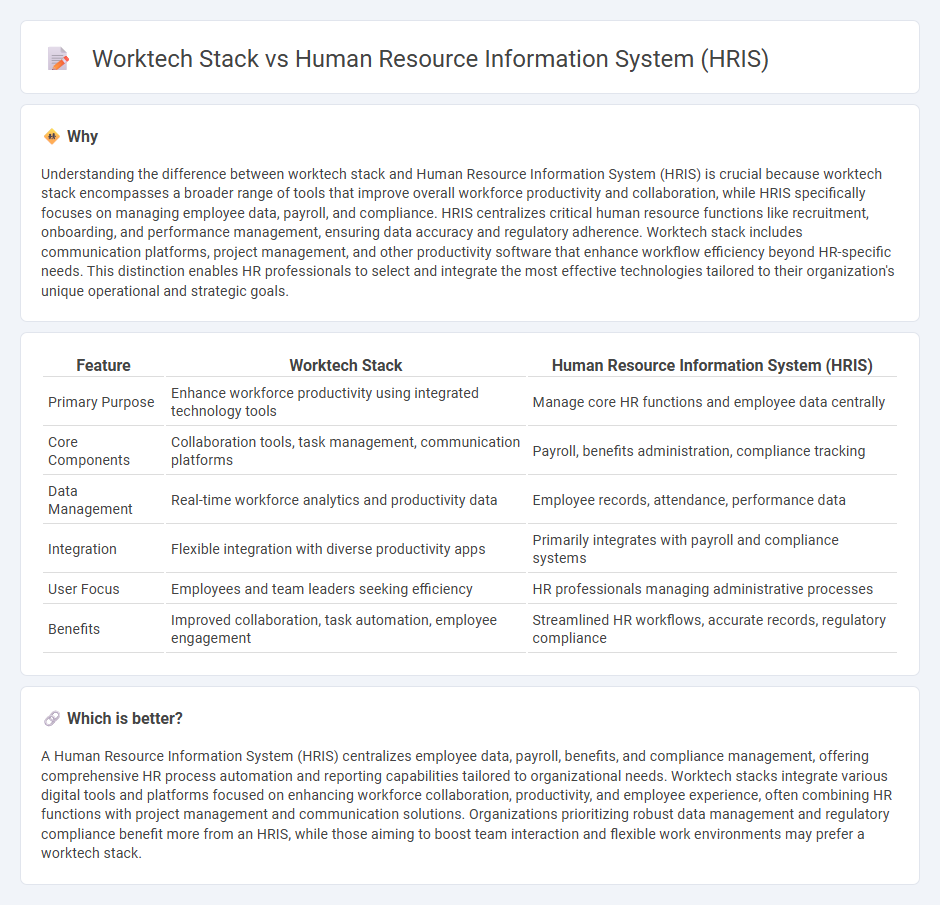
Worktech stacks encompass a broad array of digital tools designed to enhance workplace productivity, employee engagement, and collaboration, integrating platforms like Slack, Zoom, and project management software. Human Resource Information Systems (HRIS) specifically focus on managing core HR functions such as payroll, benefits administration, recruitment, and compliance through centralized databases and automation. Explore the distinct advantages and optimal use cases of worktech stacks versus HRIS to elevate your human resources strategy.
Why it is important
Understanding the difference between worktech stack and Human Resource Information System (HRIS) is crucial because worktech stack encompasses a broader range of tools that improve overall workforce productivity and collaboration, while HRIS specifically focuses on managing employee data, payroll, and compliance. HRIS centralizes critical human resource functions like recruitment, onboarding, and performance management, ensuring data accuracy and regulatory adherence. Worktech stack includes communication platforms, project management, and other productivity software that enhance workflow efficiency beyond HR-specific needs. This distinction enables HR professionals to select and integrate the most effective technologies tailored to their organization's unique operational and strategic goals.
Comparison Table
| Feature | Worktech Stack | Human Resource Information System (HRIS) |
|---|---|---|
| Primary Purpose | Enhance workforce productivity using integrated technology tools | Manage core HR functions and employee data centrally |
| Core Components | Collaboration tools, task management, communication platforms | Payroll, benefits administration, compliance tracking |
| Data Management | Real-time workforce analytics and productivity data | Employee records, attendance, performance data |
| Integration | Flexible integration with diverse productivity apps | Primarily integrates with payroll and compliance systems |
| User Focus | Employees and team leaders seeking efficiency | HR professionals managing administrative processes |
| Benefits | Improved collaboration, task automation, employee engagement | Streamlined HR workflows, accurate records, regulatory compliance |
Which is better?
A Human Resource Information System (HRIS) centralizes employee data, payroll, benefits, and compliance management, offering comprehensive HR process automation and reporting capabilities tailored to organizational needs. Worktech stacks integrate various digital tools and platforms focused on enhancing workforce collaboration, productivity, and employee experience, often combining HR functions with project management and communication solutions. Organizations prioritizing robust data management and regulatory compliance benefit more from an HRIS, while those aiming to boost team interaction and flexible work environments may prefer a worktech stack.
Connection
Worktech stack integrates various digital tools and platforms that enhance workforce management, while Human Resource Information System (HRIS) serves as the centralized software for managing employee data, payroll, recruitment, and performance tracking. The connection between worktech stack and HRIS lies in seamless data synchronization and automation, enabling efficient talent acquisition, onboarding, and employee lifecycle management. Effective integration of these systems optimizes HR workflows, improves decision-making, and fosters a data-driven approach to human resource management.
Key Terms
Data Integration
Human Resource Information Systems (HRIS) centralize employee data, payroll, benefits, and compliance management into a unified platform, enabling seamless data integration across various HR functions. Worktech stacks combine diverse productivity tools like collaboration software, project management, and communication apps but often face challenges in consolidating data due to heterogeneous systems. Explore how optimizing data integration between HRIS and worktech stacks can streamline operations and enhance workforce analytics insights.
Automation
Human Resource Information System (HRIS) centralizes employee data management while automating payroll, benefits administration, and compliance tracking, enhancing HR operational efficiency. Worktech stack integrates diverse digital collaboration and productivity tools, automating tasks like scheduling, communication, and project management to improve workforce agility. Explore detailed insights on how automation in HRIS and worktech stacks transform modern workplace efficiency.
Employee Self-Service
Human Resource Information System (HRIS) platforms centralize employee data management, streamlining payroll, benefits administration, and compliance tracking, whereas worktech stacks integrate diverse tools enhancing collaboration, communication, and productivity beyond traditional HR functions. Employee Self-Service (ESS) features in HRIS provide employees with direct access to personal records, leave requests, and benefit enrollments, promoting autonomy and reducing administrative burden. Explore how leveraging both HRIS and worktech solutions can transform your workforce management for greater efficiency and engagement.
Source and External Links
What Is HRIS? | Oracle - An HRIS (Human Resource Information System) is software that maintains, manages, and processes detailed employee information and HR policies, streamlining HR tasks and facilitating accurate record keeping and reporting, sometimes overlapping with HRMS and HCM systems depending on features used.
HRIS (human resource information system) By - TechTarget - An HRIS is software that manages and automates core HR processes by providing a centralized repository of employee data, supporting functions such as recruiting, time tracking, performance appraisals, and benefits administration.
What is an HRIS (Human Resource Information System)? - HiBob - HRIS software centralizes and automates HR activities like payroll, benefits, time tracking, and employee data management, improving efficiency, compliance, and enabling HR strategic decision-making through features such as onboarding, analytics, and self-service portals.
 dowidth.com
dowidth.com